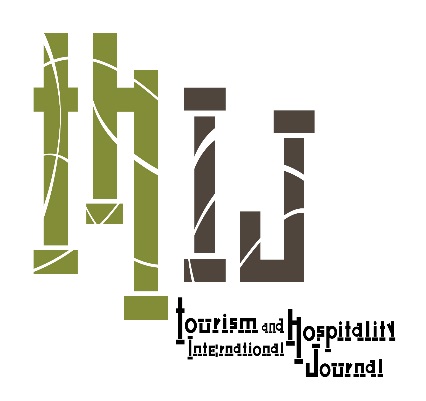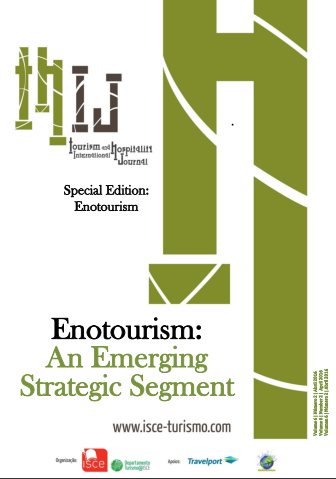Ecossistema de Enoturismo: proposta de modelo de coopetição entre as partes interessadas
DOI:
https://doi.org/10.57883/thij6(2)2016.30308Keywords:
Enotourism, Ecosystem, Stakeholder Analysis, CoopetitionAbstract
Wine as a cultural product became the main theme of tourism development in most wine regions in the World and in Portugal. Enotourism is a growing ecosystem, composed by Territory, Tourism and Wine Culture subsystems, involving more than visiting wineries and buy wine, emerging related to landscape, heritage, identity and places memory, following sustainable principles. It is crucial value generation, based on regions’ endogenous resources, anchored on coopetitive strategies. It is also vital to identify main stakeholders within Enotourism ecosystem and analyze theirs coopetitive relationship. In this context, this study proposes an aggregator ecosystem model - Enotourism Coopetition Model. This archetype recognizes the ecosystem players’ diversity, reinforced by sectorial policies, in order to promote authenticity, competitiveness and sustainability. To explore this framework, a qualitative methodology was adopted - Schmeer’s Stakeholder Analysis. The proposed model application will support managers and decision-makers to identify the main actors and interact more effectively, seeking a sustainable territorial value creation; fostering local endogenous resources; strengthening regional landscape identity and increase businesses competitiveness sustainability. It is argued that players must build a common vision and mission, incorporating the needs of those who have Enotourism interests, which could encourage a responsible attitude/behavior focused on: the sense of cultural heritage identity pride; recognition the sector niche as an important vehicle for regional development and local communities’ sharing; commitment to explore the rural landscape´s multifunctionalities; and assigning Enotourism innovative experiences projects, as a priority.
References
Ballart, Josep. (1997). El Património Histórico y Arqueológico: Valor Y Uso. Barcelona: Editorial Ariel Patrimonio Historico.
Brussard, P., Reed, J., & Richard, C., (1998). Ecosystem management: what is it really? Landscape and Urban Planning, Volume 40, Issues 1–3, 31 March 1998, Pages 9–20.
Butler, R. W. & Waldrook, L., (2003). A new planning tool: the tourism opportunity spectrum. The Journal of Tourism Studies. v. 14, n 1, p. 25-36, may.
Carlsen, J. & Carters, S. (Org.) (2004). Wine Tourism. (Special Issue), Journal of Wine Research (15, 1). Oxford: Carfax Publishing.
Cavaco, C., & Fonseca, L., (2001). Território e Turismo no Brasil: uma introdução. Lisboa: CEG.
Chuck Y. (1997). International Tourism: a Global Perspective. World Tourism Organization (WTO) Publications, Madrid.
Charters, S., and Ali-Knight, J., (2002). Who is the wine tourist?. Tourism Management, 23 (3), pp. 311-319.
Cooper, C., & Hall, C., M., (2008). Contemporary Tourism. Routledge Taylor & Francis Group.
Costa, A. (2007). O Enoturismo em Portugal: o caso das Rotas do Vinho. Revista da Ciência da Administração (vol01, jan/jun), Universidade de Pernambuco: versão electrónica.
Dahringer, L. and Muchlbacher, H., (1991). International Marketing. Addison Wesley, Wokingham.
Deloitte Vintur Project (2005). European Enotourism HANDBOOK. Project: “VINTUR”
Douro Valley, North Portugal, (2008). Executive Report of the System for Measuring Excellence in Destinations. In http://www.ccdr-n.pt/sites/default/files /ficheiros_ccdrn/ missaodouro/pub_smed_ingles.pdf
Dyer, J., (2000). Collaborative Advantage: Winning through Extended Enterprise Supplier. Oxford University Press Networks.
European Landscape Convention, (2000). Foreign and Commonwealth Office, King Charles Street, London, SW1A 2AH. http://www.official-documents.gov.uk/
Freeman, C. (1982). The economics of industrial innovation. Cambridge: MIT press.
Getz, D. & Brown, Granham (2006). Benchmarking wine tourism development: the case of the Okanagan Valley, British Columbia, Canada. International Journal of Wine Marketing (18,2), Emerald.
Getz, D. (2000). Explore Wine Tourism: management, development & destinations. Cognizant Communication Corp
Getz, D., (2000). Explore Wine Tourism: management, development & destinations. Cognizant Communication Corp
Goeldner, R. and Ritchie, B., (2006). Tourism: Principles, Practices, Philosophies. Hoboken (NJ), John Wiley & Sons, (10th ed.)
Hall, C. ; Johnson, G.; Cambourne, B.; Macionis, N.; Mitchell, R.; Sharples, L.; (2000). Wine tourism: an introduction in Wine Tourism Around the World –Development, management and markets.Butterworth-Heinemann. Oxford.
Hall, C. Michael, et al. (eds.) (2002). Wine Tourism around the World – Development, management and markets. Oxford: Butterworth-Heinemann.
Hall. C., (1996). Wine Tourism in New Zeland. In J. Higham (Ed.). Proceedings of Tourism Down Under II. Research Conference (pp.109-119). Dunedin: University of Otago.
Hjalager, A. & Richards, G. (Eds.) (2002). Tourism and Gastronomy. Oxon: Routledge.
Howley & Westering (1999). Wine tourism in the United Kingdom. in Hall e tal (2000). Wine Tourism Around the World, – Development, management and markets. Oxford: Butterworth-Heinemann. pp. 175-189
Howley, M. & Westering, J. (2008). Developing wine tourism: A case study of the attitude of English wine producers to wine tourism . Journal of Vacation Marketing , vol. 14, no. 1, pp. 87-95
Inácio, A. (2010). O destino enoturístico: desenvolvimento local e criação de valor. Journal of Tourism Studies, pp 39-64. COGITUR
Inácio, A., (2008). O Enoturismo em Portugal: da “Cultura ” do vinho ao vinho como cultura. Universiadde de Lisboa, Faculdade de Letras. Departamento Geografia. Tese doutoramento.
Jenkins, D., (2002) (Editor). Culture: a driving force for urban tourism – Application of Experiences to Countries in transition. Friedrich Ebert stiftung.http://www.culturelink.org/publics/joint/tourism01/Jelincic_Urban_Tourism.pdf#page=85.
Martin, E. and Williams, P. (2003) Directions in British Columbia wine tourism policy. International Journal of Contemporary Hospitality Management 15 (6), 317–23.
Middleton, V., (1994). Marketing in travel and tourism. Butterworth Heinemann, Oxford.
Moore, J., (1993). Predators and prey: a new ecology of competition. Harvard Business Review, May-June, 75-86
Moore, J., (1997). Death of Competition: Leadership and strategy in the age of business ecosystems. HarperBusiness. ISBN: 0887308503. Reprint edition
Moore, J., (2006). Business ecosystems and the view from the firm. Antitrust Bulletin: Spring 2006, 51, 1. ABI/INFORM Global, p. 31
Novelli, M., (2005). Niche Tourism: Contemporary Issues, Trends and Cases. Routledge.Elsevier Butterworth-Heinemann (Editor).
O´Neill M., Palmer A., (2006). Wine Production and Tourism: Adding Service to a a Perfect Partnership. Cornell Hotel and Restaurant Administration Quarterly, 45
Pereiro, P., X., (2003). Patrimonialização e transformação das identidades culturais. In Portela, J. & Castro Caldas, J. (coords.). Portugal Chão. Oeiras: Celta editora, pp. 231-247.
Peltoniemi, M., (2005). Business Ecosystem: a conceptual modeç of an organization population from the perspective of complexity and evolution. E-Business Research Center, Research report 18. Tampere: Tampere University of Technology (TUT) and University of Tampere. Available in www.ebrc.fi accessed on 10.10.2015.
Poitras, L., and Donald, G., (2006). Sustainable Wine Tourism: The Host Community Perspective. Journal of Sustainable Tourism, 14: 5, 425 — 448
Post, J., Preston, L., & Sachs, S., (2002). Redefining the Corporation Stakeholder Management and Organizational Wealth. Publisher Stanford University Press. ISBN 080474310-X.
Schmeer, K., (1999). Guidelines for Conducting a Stakeholder Analysis. Bethesda, MD: Partnerships for Health Reform, Abt Associates Inc.
Tansley, A. G., (1935). The use and abuse of vegetational concepts and terms. In Functional Ecology, Volume 11, Issue 2, Article first published online: 19 SEP 2008.
Tapscott, D., Ticoll D., e Lowy, A.,(2000). Digital Capital. Boston, MA: Harvard Business School Press.
TP-Turismo de Portugal, (2020). Plano Estratégico para o Turismo. Lisgráfica, Impressão e Artes Gráficas, S.A.Lisboa.
TP-Turismo de Portugal, (2013). Plano Estratégico para o Turismo. Lisgráfica, Impressão e Artes Gráficas, S.A.Lisboa.
TP-Turismo de Portugal (2014). Enoturismo em Portugal. In http://www.turismodeportugal.pt/Portugu%C3%AAs/ProTurismo/competitividadeeinovacao/setoresdeatividade/Documents/Carateriza%C3%A7%C3%A3o%20das%20Unidades%20de%20Enoturismo.pdf
TP-Turismo de Portugal, (2015). Inquérito a Turistas Abril de 2015. In http://www.turismodeportugal.pt/Português/ProTurismo/estatísticas/EstudosdeSatisfacaodosTuristas/Documents/Inquérito%20a%20Turistas%20CI_vaga%20inverno%202015.pdf
Urry, J. (1999). O Olhar do Turista: Lazer e Viagens nas Sociedades Contemporâneas. 2ª. Ed. Studio Nobel/SESC: São Paulo.
Williams, W. & Kelly, J., (2001). Cultural Wine Tourists: Product Development Considerations for British Columbia’s Resident Wine Tourism Market. International Journal of Wine Marketing (13,3). U.K.: Emerald; 59-76.
Zineldin, M. (2004). Co-opetition:The organisation of the future. Marketing Intelligence & Planning,22(6/7), 780-789.
Zook C., & Allen, J., (2001). Profit from the Core. Published by: Harvard Business School Press. In http://vedpuriswar.org/Book_Review/Business_Strategy/Profit%20from %20the%20Core.pdf.
Downloads
Published
How to Cite
Issue
Section
License
Copyright (c) 2016 This work is licensed under a Creative Commons - Attribution 4.0 International (CC BY 4.0)

This work is licensed under a Creative Commons Attribution 4.0 International License.
This work is published under the Creative Commons Attribution 4.0 International License.






